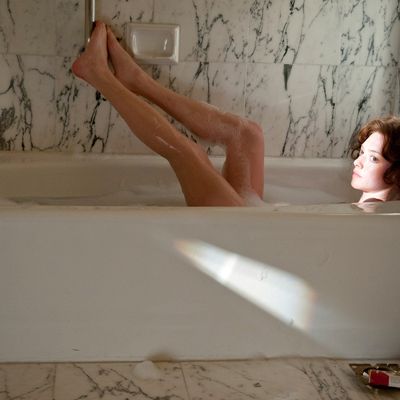
Lindsay Lohan was up for a role as Linda Lovelace, and I’m fairly certain it would have been worth the hell of having her bad self on set. The real Lovelace gave off a blow-job-queen-next-door aura that was later belied — shockingly — by her stories of abuse at the hands of her spouse-agent-pimp. Good as Amanda Seyfried is, she’s too conventionally pretty and demure to capture the blowsiness that is (sadly) natural to Lohan nowadays.
The biopic we have, Lovelace, is a straightforward story of victimhood enlivened by fun seventies montages (what a cringe-worthy era — everyone wore costumes) and some big yet finely tuned performances. You have to put up with the usual biopic clunkery, but by the time the fresh-faced Linda is sprung from her ultrareligious home by scruffy hustler Chuck Traynor (Peter Sarsgaard), our curiosity is piqued: Just how much of Linda’s talent will Seyfried be required to reproduce?
Not much, given the R rating, but Bobby Cannavale, Hank Azaria, and Chris Noth as porn purveyors do a stellar job expressing amazement at Linda’s (offscreen) ability to swallow an entire large penis. Directors Rob Epstein and Jeffrey Friedman (best known for docs like The Celluloid Closet) tell Linda’s story twice. The first time through is upbeat, as Linda and Deep Throat become national sensations. (Adam Brody plays Harry Reems as a sweetheart.) The second time, we see the other side — Traynor beating her, arranging gang bangs, and incurring debts that force her back into porn.
Sarsgaard gives an astutely measured performance: Scene by scene, he gets wilder and more violent. There’s a lot of stunt casting: Eric Roberts running a lie-detector machine, James Franco as Hugh Hefner (completely missing Hef’s showy urbanity), and Sharon Stone looking tight and mean as Linda’s mom. Stone is fine, but the role isn’t filled in: Why does she exhort the desperate Linda to obey her husband when it was Traynor who led her into the bowels of hell? Epstein and Friedman end with a crawl saying Linda became an anti-porn crusader — and leave out the part where she fell on hard times and briefly went back to modeling, which could have added another layer of mystery and ambivalence. Lovelace does a respectable job, but it never goes deep.
This review originally appeared in the August 12, 2013 issue of New York Magazine.


